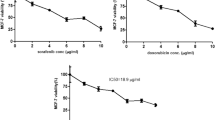Abstract
Background
miR-17-5p is reported to be overexpressed in pancreatic cancer, and it plays an important role in carcinogenesis and cancer progression. Gemcitabine is the standard first-line chemotherapeutic agent for pancreatic cancer, however the chemoresistance limits the curative effect.
Aims
In the present study, we investigated whether inhibition of miR-17-5p could enhance chemosensitivity to gemcitabine in pancreatic cancer cells.
Methods
miR-17-5p inhibitor was transfected to pancreatic cancer cell lines Panc-1 and BxPC3, and then cell proliferation, cell apoptosis, caspase-3 activation, and chemosensitivity to gemcitabine were measured in vitro.
Results
Our data showed that Panc-1 and BxPC3 cells transfected with miR-17-5p inhibitor showed growth inhibition, spontaneous apoptosis, higher caspase-3 activation, and increased chemosensitivity to gemcitabine. In addition, miR-17-5p inhibitor upregulated Bim protein expression in a dose-dependent manner without changing the Bim mRNA level, and it increased the activity of a luciferase reporter construct containing the Bim-3′ untranslated region.
Conclusions
These results prove that miR-17-5p negatively regulates Bim at the posttranscriptional level. We suggest that miR-17-5p inhibitor gene therapy would be a novel approach to chemosensitization for human pancreatic cancer.







Similar content being viewed by others
References
Assifi MM, Hines OJ. Anti-angiogenic agents in pancreatic cancer: a review. Anticancer Agents Med Chem. 2011;11:464–469.
Liu WS, Yan HJ, Qin RY, et al. siRNA directed against survivin enhances pancreatic cancer cell gemcitabine chemosensitivity. Dig Dis Sci. 2009;54:89–96.
Kato H, Seto K, Kobayashi N, et al. CCK-2/gastrin receptor signaling pathway is significant for gemcitabine-induced gene expression of VEGF in pancreatic carcinoma cells. Life Sci. 2011;89:603–608.
Xu Y, Xia F, Ma L, et al. MicroRNA-122 sensitizes HCC cancer cells to adriamycin and vincristine through modulating expression of MDR and inducing cell cycle arrest. Cancer Lett. 2011;310:160–169.
Xia L, Zhang D, Du R, et al. miR-15b and miR-16 modulate multidrug resistance by targeting BCL2 in human gastric cancer cells. Int J Cancer. 2008;123:372–379.
Zhu W, Shan X, Wang T, et al. miR-181b modulates multidrug resistance by targeting BCL2 in human cancer cell lines. Int J Cancer. 2010;127:2520–2529.
Li Y, Zhu X, Gu J, et al. Anti-miR-21 oligonucleotide sensitizes leukemic K562 cells to arsenic trioxide by inducing apoptosis. Cancer Sci. 2010;101:948–954.
Galluzzi L, Morselli E, Vitale I, et al. miR-181a and miR-630 regulate cisplatin-induced cancer cell death. Cancer Res. 2010;70:1793–1803.
Hummel R, Hussey DJ, Haier J. MicroRNAs: predictors and modifiers of chemo- and radio-therapy in different tumour types. Eur J Cancer. 2010;46:298–311.
O’Donnell KA, Wentzel EA, Zeller KI, et al. c-Myc-regulated microRNAs modulate E2F1 expression. Nature. 2005;435:839–843.
Yu J, Ohuchida K, Mizumoto K, et al. MicroRNA miR-17-5p is overexpressed in pancreatic cancer, associated with a poor prognosis, and involved in cancer cell proliferation and invasion. Cancer Biol Ther. 2010;10:748–757.
Osada H, Takahashi T. let-7 and miR-17-92: small-sized major players in lung cancer development. Cancer Sci. 2011;102:9–17.
Bonauer A, Dimmeler S. The microRNA-17-92 cluster: still a miRacle? Cell Cycle. 2009;8:3866–3873.
Tagawa H, Karube K, Tsuzuki S, et al. Synergistic action of the microRNA-17 polycistron and Myc in aggressive cancer development. Cancer Sci. 2007;98:1482–1490.
Hossain A, Kuo MT, Saunders GF. mir-17-5p regulates breast cancer cell proliferation by inhibiting translation of AIB1 mRNA. Mol Cell Biol. 2006;26:8191–8201.
Doebele C, Bonauer A, Fischer A, et al. Members of the microRNA-17-92 cluster exhibit a cell-intrinsic antiangiogenic function in endothelial cells. Blood. 2010;115:4944–4950.
Wang Q, Li YC, Wang J, et al. miR-17-92 cluster accelerates adipocyte differentiation by negatively regulating tumor-suppressor Rb2/p130. Proc Natl Acad Sci USA. 2008;105:2889–2894.
Zivny J, Klener P Jr, Pytlik R, et al. The role of apoptosis in cancer development and treatment: focusing on the development and treatment of hematologic malignancies. Curr Pharm Des. 2010;16:11–33.
Ola MS, Nawaz M, Ahsan H. Role of Bcl-2 family proteins and caspases in the regulation of apoptosis. Mol Cell Biochem. 2011;351:41–58.
Happo L, Strasser A, Cory S. BH3-only proteins in apoptosis at a glance. J Cell Sci. 2012;125:1081–1087.
Ren D, Tu HC, Kim H, et al. BID, BIM, and PUMA are essential for activation of the BAX- and BAK-dependent cell death program. Science. 2010;330:1390–1393.
Ohgushi M, Kuroki S, Fukamachi H, et al. Transforming growth factor beta-dependent sequential activation of Smad, Bim, and caspase-9 mediates physiological apoptosis in gastric epithelial cells. Mol Cell Biol. 2005;25:10017–10028.
Li R, Moudgil T, Ross HJ, et al. Apoptosis of non-small-cell lung cancer cell lines after paclitaxel treatment involves the BH3-only proapoptotic protein Bim. Cell Death Differ. 2005;12:292–303.
Kutuk O, Letai A. Displacement of Bim by Bmf and Puma rather than increase in Bim level mediates paclitaxel-induced apoptosis in breast cancer cells. Cell Death Differ. 2010;17:1624–1635.
Gillings AS, Balmanno K, Wiggins CM, et al. Apoptosis and autophagy: BIM as a mediator of tumour cell death in response to oncogene-targeted therapeutics. FEBS J. 2009;276:6050–6062.
Egle A, Harris AW, Bouillet P, et al. Bim is a suppressor of Myc-induced mouse B cell leukemia. Proc Natl Acad Sci USA. 2004;101:6164–6169.
Lakhani SA, Masud A, Kuida K, et al. Caspases 3 and 7: key mediators of mitochondrial events of apoptosis. Science. 2006;311:847–851.
Fontana L, Fiori ME, Albini S, et al. Antagomir-17-5p abolishes the growth of therapy-resistant neuroblastoma through p21 and BIM. PLoS One. 2008;3:e2236.
Acknowledgments
This work was supported by the National Natural Science Foundation of China (Grant 81201676, 30972703, 81171653), and the science and technology project for young talent by Changzhou Municipal Health Bureau (Grant QN201103).
Conflict of interest
None.
Author information
Authors and Affiliations
Corresponding authors
Additional information
Hai-jiao Yan and Wen-song Liu contributed equally to this study.
Electronic supplementary material
Below is the link to the electronic supplementary material.
Rights and permissions
About this article
Cite this article
Yan, Hj., Liu, Ws., Sun, Wh. et al. miR-17-5p Inhibitor Enhances Chemosensitivity to Gemcitabine Via Upregulating Bim Expression in Pancreatic Cancer Cells. Dig Dis Sci 57, 3160–3167 (2012). https://doi.org/10.1007/s10620-012-2400-4
Received:
Accepted:
Published:
Issue Date:
DOI: https://doi.org/10.1007/s10620-012-2400-4




